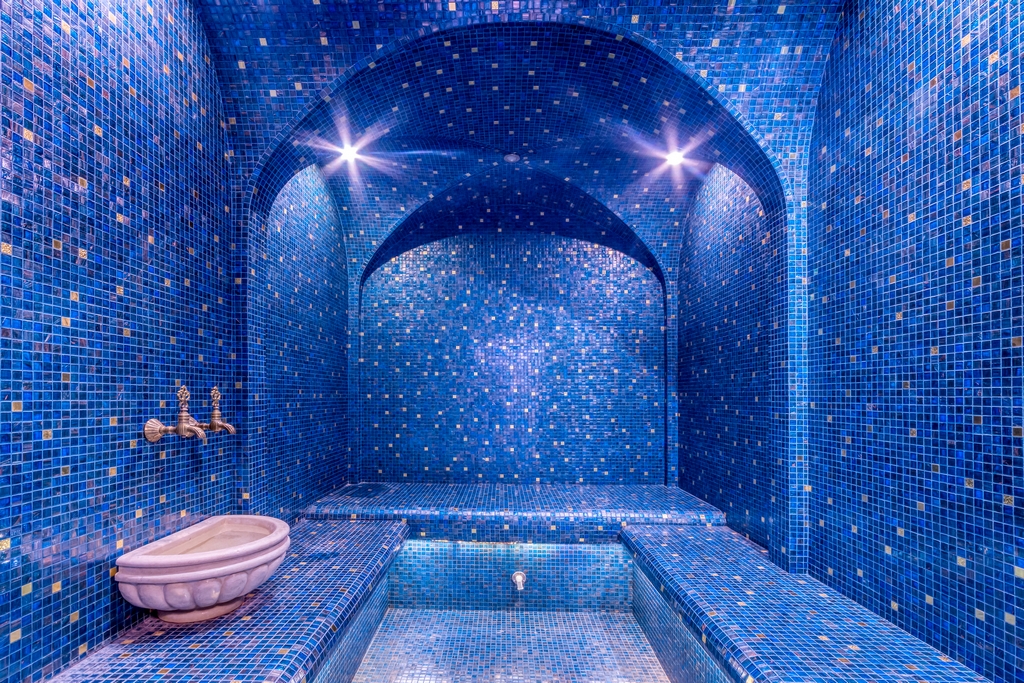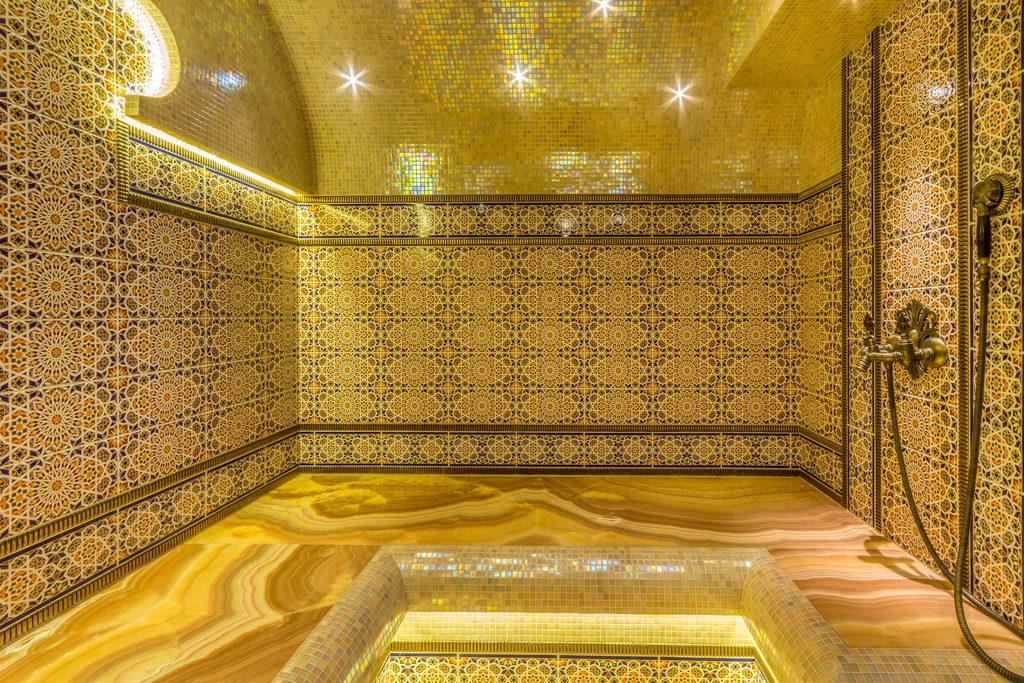Inside Turkish Baths


As the wellness trend surges the world over, the traditional practice and design of Turkish baths are gaining renewed interest, both for the health benefits they afford, as well as their aesthetic beauty. Here’s a peak inside these exotic havens of rest and rejuvenation.
By Worthy McCargo
Turkish baths, also known as hammams, hold a rich history and cultural significance dating back centuries. From their intricate architectural designs to the meticulous rituals performed within, Turkish baths offer a unique experience that intertwines physical relaxation with spiritual rejuvenation.
The design of Turkish baths is characterized by a blend of functionality, elegance, and symbolism, that are first reflected in their layout and design. Traditionally, these baths consist of several interconnected rooms, each serving a specific purpose.
The entrance hall, or “camekan,” welcomes guests into the bathhouse and features ornate decorations, often including elaborate mosaic tiles and marble columns. From there, visitors proceed to the “sogukluk,” or cold room, where they undress and acclimate to the temperature. This room typically leads to the “sicaklik,” or hot room, where the heart of the bathing experience unfolds.
The hot room is the focal point of the hammam, designed to promote sweating and detoxification. Its centerpiece is the “gobek tasi,” a raised marble platform where bathers recline to receive treatments such as scrubbing and massages. Surrounding the gobek tasi are alcoves or niches adorned with intricate tile work, creating a visually stunning environment that enhances relaxation and contemplation.
PLEASURE PRACTICE
As for rituals, Turkish baths are steeped in centuries-old customs that emphasize cleanliness, purification, and socialization. Upon entering the hot room, bathers are greeted by the soothing warmth of the steam and the rhythmic splashing of water. Attendants, known as “tellak” or “natir,” assist guests with bathing rituals, which often involve a series of steps to cleanse and invigorate the body.
One of the most iconic rituals is the “kese,” or exfoliation, where a rough mitt or glove is used to scrub away dead skin cells and impurities. This process not only promotes smoother skin but also improves circulation and stimulates the lymphatic system. Following the kese, bathers may receive a massage with fragrant oils, further enhancing relaxation and sensory indulgence.
Beyond the physical benefits, Turkish baths also offer a sanctuary for socializing and spiritual reflection. Historically, these spaces served as community hubs where people from all walks of life would converge to unwind, exchange gossip, and forge bonds. Today, Turkish baths continue to foster a sense of camaraderie and belonging, providing a respite from the hustle and bustle of modern life.
In terms of health benefits, frequenting Turkish baths is believed to promote overall well-being and vitality. The combination of heat, steam, and massage therapy can alleviate muscle tension, improve respiratory function, and enhance mental clarity. Moreover, the detoxifying effects of sweating help rid the body of toxins and impurities, promoting clearer skin and a stronger immune system.
Studies have also shown that regular sauna use, a key component of Turkish baths, can have cardiovascular benefits, such as lowering blood pressure and improving circulation. Additionally, the relaxation induced by hammam rituals can reduce stress levels and promote better sleep, contributing to overall mental and emotional health.
AGELESS APPEAL
Despite the advent of modern spa facilities and wellness trends, Turkish baths remain immensely popular, both in Turkey and beyond. Their timeless allure lies in their ability to transcend mere physical indulgence and provide a holistic experience that nourishes the body, mind, and spirit.
Whether seeking relaxation, rejuvenation, or social connection, patrons continue to flock to Turkish baths, drawn by the promise of serenity and renewal amidst the soothing embrace of steam and marble.
Here are five of the world’s most famous Turkish baths:
Çemberlitaş Hamamı (Çemberlitaş, Istanbul, Turkey)
Located in the heart of Istanbul’s historic district, Çemberlitaş Hamamı is one of the city’s most renowned and oldest Turkish baths, dating back to 1584. Designed by the renowned Ottoman architect Mimar Sinan, it features stunning architecture with intricate marble work and a large central dome.
Çemberlitaş Hamamı (Fatih, Istanbul, Turkey)
Another famous hammam in Istanbul, Çemberlitaş Hamamı dates back to the 16th century. It boasts an impressive dome and a luxurious atmosphere. This hammam is known for its authentic Turkish bath experience.
Cagaloglu Hamamı (Sultanahmet, Istanbul, Turkey)
Constructed in 1741 during the Ottoman period, Cagaloglu Hamamı is one of the most opulent and historic Turkish baths in Istanbul. Its grand architecture features stunning domes, marble columns, and intricate tile work.
Süleymaniye Hamamı (Fatih, Istanbul, Turkey)
Located near the Süleymaniye Mosque, Süleymaniye Hamamı is another iconic Turkish bath in Istanbul. Built by the famous Ottoman architect Mimar Sinan in 1557, it is renowned for its exquisite design and serene ambiance.
Rudas Baths (Budapest, Hungary)
Although not located in Turkey, Rudas Baths in Budapest, Hungary, are historically significant as they were built during the time of Ottoman rule in the 16th century. These baths feature a unique blend of Ottoman and Hungarian architectural styles, with octagonal pools and Turkish domes. Rudas Baths are celebrated for their thermal waters, which are believed to have healing properties, making them a popular destination for relaxation and rejuvenation.
Each of these Turkish baths offers a glimpse into the rich cultural heritage and timeless tradition of Turkish bathing rituals, attracting visitors from around the world to experience their beauty and therapeutic benefits.
Turkish baths stand as enduring symbols of culture, tradition, and holistic well-being. From their exquisite architectural designs to their time-honored rituals and health-enhancing benefits, hammams offer a sanctuary for relaxation, purification, and connection.
As the popularity of spa culture continues to rise, Turkish baths remain steadfast in their appeal, offering a timeless retreat where the ancient art of bathing is celebrated and cherished.
Worthy McCargo is a writer, actor, PR specialist and part-time bouncer based in Freeport, Long Island, NY.
References include www.turkish-baths.com; www.turkishbaths.org; and The Art of Wayfaring, History of Turkish Baths, 2019.
First two photos by Alhim | Shutterstock, last photo by Muratart | Shutterstock.










